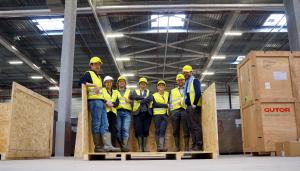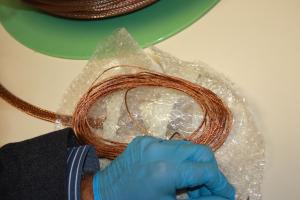Thin diagnostic coils to be fitted into giant magnets
13 Mar 2017
Last week was marked by the first delivery of diagnostic components—Continuous External Rogowski (CER) coils—from the European Domestic Agency to the ITER Organization.
Celebrating the reception of the first European diagnostic components are members of the ITER diagnostics team Jose Luis Barbero Soto, Dominique Delhom, Antoine Sirinelli, George Vayakis, Christopher Watts and Matthew Clough, as well as Guillermo Román-Pérez (from the Sgenia Group). Missing from the photo is Armand Hattat from Axon.
The CER coils are to be located on three toroidal field coils and on the spare toroidal field coil. The CER coils are designed to measure the total electric current flowing in the ITER plasma, a key measurement for plasma control that also has relevance for safety. Rogowski coils work with just one or two extended sensors, resulting in high reliability despite the cryogenic temperatures, high vacuum and mechanical stresses at this location.
Their development in their present form started in 2002, with the decision to incorporate them in the toroidal field coil casing. It involved the ITER Organization, the European Domestic Agency, the Japanese Domestic Agency, their predecessors, laboratories and suppliers. Each CER is a composite cylinder, measuring approximately 40 metres in length and 12 millimetres in diameter. A special groove is made in the toroidal field coil cases to house it. The ends of the CER coils, emerging from the toroidal field coils, are housed within steel protection structures that made up the bulk of the approximately half-tonne delivery from Europe.
These small rope-like coils are tasked with a difficult job—measuring the total electric current flowing in the ITER plasma from their location inside of the toroidal field coils cases.
The manufacturing has been undertaken by two companies—Axon in France and Sgenia in Spain. The system has been delivered to the ITER Organization where it has undergone site acceptance tests and is now ready to travel to the next destination for the coils—Japan—for installation in the dedicated toroidal field coils. A number of the ITER diagnostics team members ensured the process went without too many "hitches." Practical lessons learned with this first delivery will be very useful for ensuring subsequent deliveries go smoothly and efficiently.
Shakeib Arshad, project manager for the CER coils at the European Domestic Agency, also celebrated the occasion. "Delivery of the CER coils represents a big success, particularly in terms of collaboration between the ITER Organization, the European Domestic Agency, and European suppliers for these items. There are very complex technical interfaces involved coupled with a tight delivery schedule."
Read a report on the milestone from the European Domestic Agency here.



